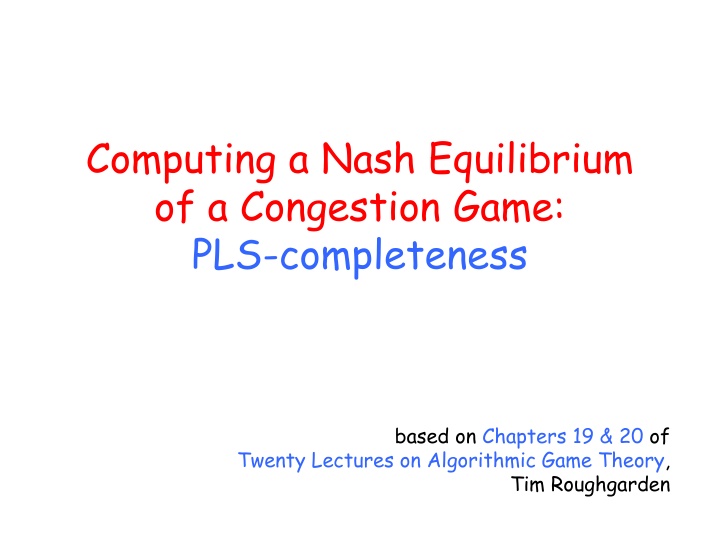
Nash Equilibrium in Congestion Games: Complexity Analysis
Explore the complexity of computing Nash Equilibrium in congestion games based on Tim Roughgarden's work on Algorithmic Game Theory. Investigate the challenges in defining dynamic convergence and computing NE efficiently.
Download Presentation

Please find below an Image/Link to download the presentation.
The content on the website is provided AS IS for your information and personal use only. It may not be sold, licensed, or shared on other websites without obtaining consent from the author. If you encounter any issues during the download, it is possible that the publisher has removed the file from their server.
You are allowed to download the files provided on this website for personal or commercial use, subject to the condition that they are used lawfully. All files are the property of their respective owners.
The content on the website is provided AS IS for your information and personal use only. It may not be sold, licensed, or shared on other websites without obtaining consent from the author.
E N D
Presentation Transcript
Computing a Nash Equilibrium of a Congestion Game: PLS-completeness based on Chapters 19 & 20 of Twenty Lectures on Algorithmic Game Theory, Tim Roughgarden
Global Connection Game G=(V,E): directed graph ce: non-negative cost of the edge e E player i has a source node siand a sink node ti Strategy for player i: a path Pifrom sito ti Given a strategy vector S, the cost of player i costi(S) = ce/ke(S) e Pi ke(S): number of players whose path contains e G 8 t1 2 6 4 cost1=7 cost2=6 s1=s2 N(S) 1 t2 8
Global Connection Game potential game a NE always exists better-response dynamics always converge to a NE Facts no one knows how to define a dynamic converging to a NE in poly-time no one knows how to compute a NE in poly-time question: can we derive an evidence that the probem is hard? (tricky) answer: theory of PLS-completeness
Congestion Game E: set of resources k players player i picks a strategy Sifrom an explicit set of strategies Si 2E each resource e E has possible costs ce(1), ce(2), , ce(k) Given a strategy vector S, the cost of player i is: costi(S) = ce(ke(S)) e Si ke(S): number of players whose chosen strategy contains e
properties of CG Congestion Game is a potential game Rosenthal potential function: ke(S) (S) = ce(i) e E i=0 a NE always exists (any local minimum of is a NE) better response dynamic converges to a NE
CG-NE problem Given an instance of Congestion Game, find any NE can we prove that CG-NE is NP-hard? .if yes, this would yield to quite surprising consequences.
Addressing a typechecking error an NP problem is a decision problem admitting short (polynomial size) witnesses for YES-instances and poly-time verifier inputs accepted by the verifier are called witnesses CG-NE is not a decision problem class FNP (Functional NP): problem just like NP probems except that, for YES-instances, a witness must be provided also called search problems An algorithm for an FNP problem: takes as input an instance outputs a witness for a YES-instance or say No .
Reduction from one search problem L1 to onother one L2 Two polynomial-time algorithms: - A1mapping instances x L1to instances A1(x) of L2 - A2mapping witnesses of A1(x) to witnesses of x (and no to no ) Notice: if L2is solvable in poly-time then L1is solvable in poly- time as well.
Theorem CG-NE is not FNP-complete unless NP=coNP proof Assume we have two poly-time algs - A1that maps every SAT formula to instances of CG-NE A1( ) - A2that maps every NE S of A1( ) to a satisfying assignment A2(S) of , if one exists, or to the string no otherwise. Then NP=CoNP. Let be unsatisfiable SAT formula, S be a NE of A1( ). S is a short, efficiently verifiable proof of the unsatisfiability of A poly-time verifier: -compute A1( ) -verify that S is a NE of A1( ) -verify that A2(S) returns no Note: we re using only the fact that every instance of CG has a NE
TFNP (total FNP): problems in FNP for which every instance has at least one witness. Theorem If a TFNP problem is FNP-complete then NP=coNP.
FNP TFNP -CG-NE -problem of finding a mixed-strategy NE for a finite game -factoring - can we prove that CG-NE is TFNP-complete? no: no complete problem is known for TFNP (and people think no one can exist) Syntactic classes Semantic classes vs
FNP TFNP -CG-NE -problem of finding a mixed-strategy NE for a finite game -factoring - PLS can we prove that CG-NE is TFNP-complete? no: no complete problem is known for TFNP (and people think no one can exist) which is the right class for CG-NE? PLS: abstract local search problems
Maximum Cut problem Input: an undirected graph G=(V,E,w) with non- negative edge weights Solution: a cut (X,Y), where X and Y are a partition of V Measure (to maximize): the weight of the cut, w(x,y) (x,y) E: x X,y Y X Y 4 8 10 1 4 3 It is NP-hard
A natural heuristic: Local search algorithm - initialize with an arbitrary cut (X,Y) - while there is an improving local move do take an arbitrary such move improving local move: move a single vertex v from one side of the cut to the other side, if this improves the weight of the current cut. local optimum: cut with no improving local move available.
local optimum vs global optimum X Y 1 4 2 6 5 3 local opt of weight 15
local optimum vs global optimum 1 X 4 2 6 5 Y 3 global opt of weight 17
local optimum vs global optimum is finding a local opt easier than finding a global opt? sometimes strictly easier: unweighted graphs - max cut is still NP-hard for unweighted graphs - local search algorithm converges in poly-time facts: - no known poly-time local search alg for finding local opt for general weights - no known poly-time alg for computing a local opt for general weights
local Max-Cut problem Given an instance of Max Cut, find any local opt. .this problem is PLS-complete.
Ingredients of an Abstract Local Search Problem The first polynomial-time algorithm takes as input an instance and outputs an arbitrary feasible solution. 1. The second polynomial-time algorithm takes as input an instance and a feasible solution, and returns the objective function value of the solution. 2. The third polynomial-time algorithm takes as input an instance and a feasible solution, and either reports locally optimal or produces a solution with better objective function value. 3.
A PLS reduction from L1to L2 Two polynomial-time algorithms: - A1mapping instances x L1to instances A1(x) of L2 -A2mapping every local optimum of A1(x) to local optimum of x Notice: if L2is solvable in poly-time then L1is solvable in poly- time as well.
Definition. A problem L is PLS-complete if L PLS and every problem in PLS reduces to it. Theorem (Johnson, Papadimitriou, Yannakakis 85, Schaffer, Yannakakis 91) Computing a local maximum of a maximum cut instance with general non-negative edge weights is a PLS-complete problem. Theorem (Johnson, Papadimitriou, Yannakakis, 85, Schaffer, Yannakakis 91) Computing a local maximum of a maximum cut instance with general non-negative edge weights using local search can require an exponential (in |V|) number of iterations, no matter how an improving local move is chosen in each iteration.
Theorem (Fabrikant, Papadimitriou, Talwar 2004) CG-NE is PLS-complete. proof CG-NE PLS 3 algorithms of the formal definition: Alg 1: given the instance, returns any strategy profile S Alg 2: given a strategy profile S, compute (S) Alg 3: given a strategy profile S, computes a better response for any player, if any, or report S is a NE . completeness: reduction from local MaxCut
proof a player for each vertex v two resources reand refor each edge e two strategies for player v: Sv= {re: e (v)} Sv= {re: e (v)} cost of a resource r {re, re}: cr(0)=cr(1)=0 and cr(2)=w(e) bijection between 2|V|strategy profiles and cuts of the graph cut corresponding to strategy profile S: (XS:={v : v plays Svin S}, YS:=V\XS) kr(S) (S) = cr(i) W = w(e) =W-W(XS,YS) r R i=0 e E (XS,YS) is a local maximum cut iff S local minimum for (S)
what about the problem of computing mixed Nash Equilibria?
MNE problem Given an instance of a 2-player game in normal form (bimatrix game), find any mixed NE Nash s theorem guarantees that a mixed NE always exists MNE TFNP no polynomial time algorithm is known for MNE what is the right class for MNE problem?
PLS: abstract local search problems nodes: feasible solutions edges: improving moves generic reason of membership: solvable by local search, i.e. by following a directed path to a sink vertex. witnesses
PPAD canonical source in- & out-degree at most 1 s generic reason of membership: solvable by following a directed path from the source to the sink vertex. witnesses
PPAD: polynomial parity argument in a directed graph canonical source in- & out-degree at most 1 s generic reason of membership: solvable by following a directed path from the source to the sink vertex. witnesses class PPAD introduced in 94 by Christos H. Papadimitriou
FNP TFNP PLS PPAD Theorem (Daskalakis, Godberg, Papadimitriou 06, Chen,Deng,Teng 06) Computing any MNE of a bimatrix game is PPAD- complete






















